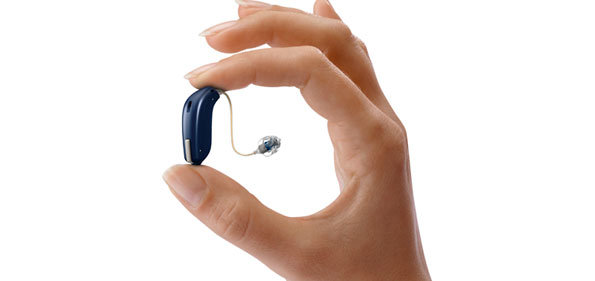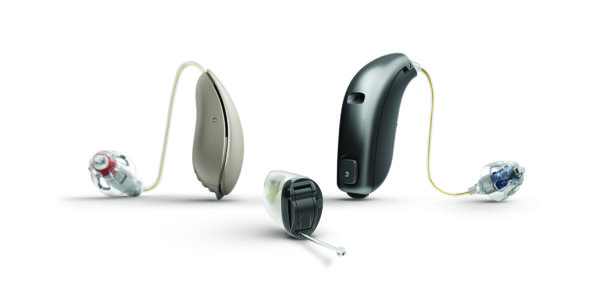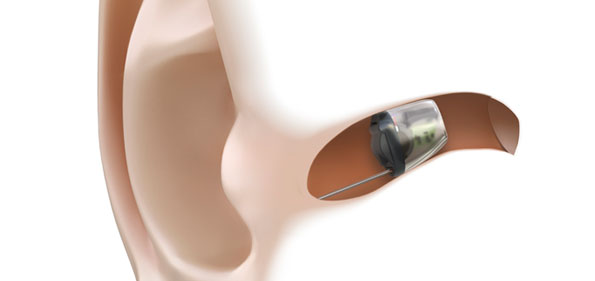CAN HEARING AIDS REDUCE LISTENING FATIGUE?
This editorial discusses the clinical implications of an independent research study and does not represent the opinions of the original authors.
A patient recently told me that he wanted to put on his glasses so he could hear me better. He was joking, but was correct in understanding that visual cues help facilitate speech understanding. When engaged in conversation, a listener uses many sources of information to supplement the auditory stimulus. Visual cues from lip-reading, gestures and expressions as well as situational cues, conversational context and the listener’s knowledge of grammar all help limit the possible interpretations of the message. Conditions that degrade the auditory stimulus, such as reverberation, background noise and hearing loss cause increased reliance on other cues in order for the listener to “fill in the blanks” and understand the spoken message. The use of these additional information sources amounts to an increased allocation of cognitive resources, which has also been referred to as increased “listening effort” (Downs, 1982; Hick & Tharpe, 2002; McCoy et al., 2005).
Research suggests that the increased cognitive effort required for hearing-impaired individuals to understand speech may lead to subjective reports of mental fatigue (Hetu et al., 1988; Ringdahl & Grimby, 2000; Kramer et al., 2006). This may be of particular concern to elderly people and those with cognitive, memory or other sensory deficits. The increased listening effort caused by hearing loss is associated with self-reports of stress, tension and fatigue (Copithorne 2006; Edwards 2007). In a study of factory workers, Hetu et al. (1988) reported that individuals with difficulty hearing at work needed increased attention, concentration and effort, leading to increased stress and fatigue. It is reasonable to conclude that listening effort as studied in the laboratory should be linked to subjective associations of hearing loss with mental fatigue, but the relationship is not clear. Dr. Hornsby points out that laboratory studies typically evaluate short-term changes in resource allocation as listening ease is manipulated in the experimental task. However, perceived mental fatigue is more likely to result from sustained listening demands over a longer period of time, e.g., a work day or social engagement lasting several hours (Hetu et al., 1988; Kramer et al., 2006).
The purpose of Dr. Hornsby’s study was to determine if hearing aids, with and without advanced features like directionality and noise reduction, reduce listening effort and subsequent susceptibility to mental fatigue. He also investigated the relationship between objective measures of speech discrimination and listening effort in the laboratory with subjective self-reports of mental fatigue.
Sixteen adult subjects participated in the study. All had bilateral, symmetrical, mild-to-severe sensorineural hearing loss. Twelve subjects were employed full-time and reported being communicatively active about 65% of the time during the day. The remaining subjects were not employed but reported being communicatively active about 61% of the day. Twelve subjects were bilateral hearing aid users and four subjects were non-users. Subjects were screened to rule out cognitive dysfunction. All participants were fitted with bilateral behind-the-ear hearing aids with slim tubes and dome ear tips. Hearing aids were programmed in basic and advanced modes. In basic mode, the microphones were omnidirectional and all advanced features except feedback suppression were turned off. In advanced mode, the hearing aids were set to manufacturer’s defaults with automatically adaptive directionality, noise reduction, reverberation reduction and wind noise reduction. All subjects wore the study hearing aids for at least 1-2 weeks before the experimental sessions began.
For the objective measurements of listening effort, subjects completed a word recognition in noise task paired with an auditory word recall task and a measure of visual reaction time. Subjects heard random sets of 8 to 12 monosyllabic words preceded by the carrier phrase, “Say the word…” They were asked to repeat the words aloud and the percentage of correct responses was scored. In addition, subjects were asked to remember the last 5 words of each list. The end of the list was indicated by the word “STOP” on a screen in front of the speaker. Subjects were instructed to press a button as quickly as possible when the visual prompt appeared. Because the lists varied from 8 to 12 items, subjects never knew when to expect the visual prompt. To control for variability in motor function, visual reaction time was measured alone in a separate session, during which subjects were instructed to simply ignore the speech and noise.
Subjective ratings of listening effort and fatigue were obtained with a five-item scale, administered prior to the experimental sessions. Three questions were adapted from the Speech Spatial and Qualities of Hearing Questionnaire (SSQ: Gatehouse & Noble, 2004) and the remaining items were formulated specifically for the study. Questions were phrased to elicit responses related to that particular day (“Did you have to put in a lot of effort to hear what was being said in conversation today?”, “How mentally/physically drained are you right now?”). The final two questions were administered before and after the dual-task session and measured changes in attention and fatigue due to participation in the experimental tasks.
The word recognition in noise test yielded significantly better results in both aided conditions than in the unaided condition, though there was no difference between the basic and advanced aided conditions. The differences between unaided and aided scores varied considerably, suggesting that listening effort for individual subjects varied across conditions. Unaided word recall was significantly poorer than basic or advanced aided performance. There was a small, significant difference between the two aided conditions, with advanced settings outperforming basic settings. In follow-up planned comparison tests, the aided vs. unaided difference was maintained though there was not a significant difference between the two aided conditions.
The reaction time measurement also assessed listening effort or the cognitive resources required for the word recognition test. Reaction times were analyzed according to listening condition as well as block, which compared the first three trials (initial block) to the last three trials (final block). Increases in reaction time by block represented the effect of task-related fatigue. Analysis by listening condition showed that unaided reaction times increased more than reaction times for the advanced aided condition but not the basic aided condition. In other words, subjects required more time to react to the visual stimulus in the unaided condition than they did in the advanced aided condition. There was no significant difference between the two aided conditions. There was a significant main effect for block; reaction times increased over the duration of the task. There was no interaction between listening condition and block; changes in performance over time were consistent across unaided and aided conditions.
One purpose of the study was to investigate the effect of hearing aid use on mental fatigue. Interestingly, comparison of initial and final blocks indicated that word recognition scores increased about 1-2% over time but improvement over time did not vary across listening conditions. There was no decrease in performance on word recall over time, nor did changes in performance over time vary significantly across listening conditions. But reaction time did increase over time for all conditions, indicating a shift in cognitive resources away from the reaction time task and toward the primary word recognition task. Though the effect of hearing aid use was not significant, a trend appeared suggesting that fewer aided listeners had increased reaction.
The questionnaires administered before the session probed perceived effort and fatigue throughout the day, whereas the questions administered before and after the task probed focus, attention and mental fatigue before and after the test session. In all listening conditions there was a significant increase in mental fatigue and difficulty maintaining attention after completion of the test session. A non-significant trend suggested some difference between unaided and aided conditions.
To identify other factors that may have contributed to variability, correlations for age, pure tone average, high frequency pure tone average, unaided word recognition score, SNR during testing, employment status and self-rated percentage of daily communicative activity were calculated with the subjective and objective measurements. None of the correlations were significant, indicating that none of these factors contributed substantially to the variability observed in the study.
Cognitive resource allocation is often studied with dual-task paradigms like the one used in this study. Decrements in performance on the secondary task indicate a shift in cognitive resources to the primary task. Presumably, factors that increase difficulty in the primary task will increase allocation of resources to the primary task. In these experiments, the primary task was a word recognition test and the secondary tasks were word recall and reaction time measurements. Improved word recall and quicker reaction times in aided conditions indicate that the use of hearing aids made the primary word recognition task easier, allowing listeners to allocate more cognitive resources to the secondary tasks. Furthermore, reaction times increased less over time in aided conditions than in unaided conditions. These findings specifically suggest that decreased listening effort with hearing aid use may have made listeners less susceptible to fatigue as the dual-task session progressed.
Though subjective reports in this study showed a general trend toward reduced listening effort and concentration in aided conditions, there was not a significant improvement with hearing aid use. This contrasts with previous work that has shown reductions in subjective listening effort with the use of hearing aids (Humes et al., 1999; Hallgren et al., 2005; Noble & Gatehouse, 2006). The author notes that auditory demands vary widely and that participants were asked to rate their effort and fatigue based on “today”, which didn’t assess perceptions of sustained listening effort over a longer period of time may not have detected subtle differences among subjects. For instance, working in a quiet office environment may not highlight the benefit of hearing aids or the difference between an omnidirectional or directional microphone program, simply because the acoustic environment did not trigger the advanced features often enough. In contrast, working in a school or restaurant might show a more noticeable difference between unaided listening, basic amplification and advanced signal processing. Though subjects reported being communicatively active about the same proportion of the day, this inquiry didn’t account for sustained listening effort over long periods of time, or varying work and social environments. These differences would likely affect overall listening effort and fatigue, as well as the value of advanced hearing aid features.
Clinical observations support the notion that hearing aid use can reduce listening effort and fatigue. Prior to hearing aid use, hearing-impaired patients often report feeling exhausted from trying to keep up with social interactions or workplace demands. After receiving hearing aids, patients commonly report being more engaged, more able to participate in conversation and less drained at the end of the day. Though previous reports have supported the value of amplification on reduced listening effort, Hornsby’s study is the first to provide experimental data for the potential ability of hearing aid use to reduce mental fatigue.
These findings have important implications for all hearing aid users, but may have particular importance for working individuals with hearing loss as well as elderly hearing impaired individuals. It is important for any working person to maintain a high level of job performance and to establish their value at work. Individuals with hearing loss face additional challenges in this regard and often take pains to prove that their hearing loss is not adversely affecting their work. Studies in workplace productivity underscore the importance of reducing distractions for maintaining focus, reducing stress and persisting at difficult tasks (Clements-Croome, 2000; Hua et al., 2011). Studies indicating that hearing aids reduce listening effort and fatigue, presumably by improving audibility and reducing the potential distraction of competing sounds, should provide additional encouragement for employed hearing-impaired individuals to pursue hearing aids.
References
Baldwin, C.L. & Ash, I.K. (2011). Impact of sensory acuity on auditory working memory span in young and older adults. Psychology of Aging 26, 85-91.
Bentler, R.A., Wu, Y., Kettel, J. (2008). Digital noise reduction: outcomes from laboratory and field studies. International Journal of Audiology 47, 447-460.
Clements-Croome, D. (2000). Creating the productive workplace. Publisher: London, E & FN Spon.
Copithorne, D. (2006). The fatigue factor: How I learned to love power naps, meditation and other tricks to cope with hearing-loss exhaustion. [Healthy Hearing Website, August 21, 2006].
Downs, M. (1982). Effects of hearing aid use on speech discrimination and listening effort. Journal of Speech and Hearing Disorders 47, 189-193.
Edwards, B. (2007). The future of hearing aid technology. Trends in Amplification 11, 31-45.
Gatehouse, S. & Noble, W. (2004). The speech, Spatial and Qualities of Hearing Scale (SSQ). International Journal of Audiology 43, 85-99.
Hallgren, M., Larsby, B. & Lyxell, B. (2005). Speech understanding in quiet and noise, with and without hearing aids. International Journal of Audiology 44, 574-583.
Hetu, R., Riverin, L. & Lalande, N. (1988). Qualitative analysis of the handicap associated with occupational hearing loss. British Journal of Audiology 22, 251-264.
Hick, C.B. & Tharpe, A.M. (2002). Listening effort and fatigue in school-age children with and without hearing loss. Journal of Speech, Language and Hearing Research 45, 573-584.
Hua, Y., Loftness, V., Heerwagen, J. & Powell, K. (2011). Relationship between workplace spatial settings and occupant-perceived support for collaboration. Environment and Behavior 43, 807-826.
Humes, L.E., Christensen, L. & Thomas, T. (1999). A comparison of the aided performance and benefit provided by a linear and a two-channel wide dynamic range compression hearing aid. Journal of Speech, Language and Hearing Research 42, 65-79.
Kramer, S.E., Kapteyn, T.S. & Houtgast, T. (2006). Occupational performance: comparing normal-hearing and hearing-impaired employees using the Amsterdam Checklist for Hearing and Work. International Journal of Audiology 45, 503-512.
McCoy, S.L., Tun, P.A. & Cox, L.C. (2005). Hearing loss and perceptual effort: Downstream effects on older adults’ memory for speech. Quarterly Journal of Experimental Psychology A 58, 22-33.
Noble, W. & Gatehouse, S. (2006). Effects of bilateral versus unilateral hearing aid fitting on abilities measured by the SSQ. International Journal of Audiology 45, 172-181.
Picou, E.M., Ricketts, T.A. & Hornsby, B.W. (2011). Visual cues and listening effort: Individual variability. Journal of Speech, Language and Hearing Research 54, 1416-1430.
Picou, E.M., Ricketts, T.A. & Hornsby, B.W. (2013). The effect of individual variability on listening effort in unaided and aided conditions. Ear and Hearing (in press).
Ringdahl, A. & Grimby, A. (2000). Severe-profound hearing impairment and health related quality of life among post-lingual deafened Swedish adults. Scandinavian Audiology 29, 266-275
Sarampalis, A., Kalluri, S. & Edwards, B. (2009). Objective measures of listening effort: Effects of background noise and noise reduction. Journal of Speech, Language and Hearing Research 52, 1230-1240.
Valente, M. & Mispagel, K. (2008) Unaided and aided performance with a directional open-fit hearing aid. International Journal of Audiology 47(6), 329-336.


